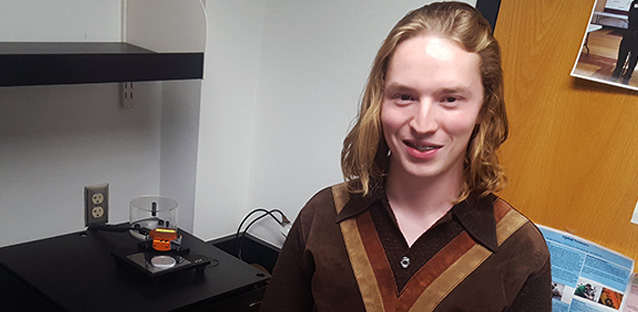- Physics Undergraduate Receives Grant to Study Nanotechnologies
UNC student Jacob Fry, a senior physics major, received more than $1,000 in grants from the UNC Office of Undergraduate Research to compare the chemical make-up of shark teeth using two nanotechnologies as well as to develop a lab curriculum on those technologies.
Nanotechnology is basically science, engineering and technology conducted at the nanoscale, equal to one billionth of a meter. It allows researchers to see a vivid image of an item at the atomic and molecular scale.
Fry used two nanotechnologies — Atomic Force Microscopy (AFM) and Scanning Electron Microscopy (SEM) — and found that the AFM provided a great image of samples with flat surfaces, but the SEM provided more detail and information about the sample.
From this, he created lab curriculum used during the spring 2019 semester as a how-to guide for these nanotechnologies.
- Two Associate Professors Present Research in Saudi Arabia
In February, UNC Associate Professors of Special Education Jennifer Ritchotte, Ph.D., and Hasan Zaghlawan, Ph.D., attended and presented their research at the International Conference for Talented People with Disability in Saudi Arabia.
Their research was supported by the Bresnahan-Halstead Center and was published in Gifted Child Quarterly. It’s the first research study in gifted education to demonstrate a causal relationship between an intervention and outcomes using single-case research methodology.
- Exploring El Niño’s Influence on Diseases Through GIS Mapping
Peru is considered ground-zero for El Niño events to unfold. Assistant Professor in Geography & GIS Jieun Lee, Ph.D., along with Ivan Ramírez, Ph.D., a geography and environmental sciences instructor at CU Denver, recently published research on how the 1998 El Niño event affected numerous climate-sensitive diseases in Peru using GIS mapping technology.
They discovered connections between the flooding and torrential rainfall that occurred with the 1998 El Niño event and outbreaks of diseases.
“The main goal of the study was to develop ways to think about and visualize the occurrence of multiple infectious disease outbreaks that emerge during extreme weather or climatic events,” said Ramírez.
Ramírez worked with Lee to fully map the concentrated instances (known as hot spots) of the diseases over time in that area of Peru. They tracked diseases that included cholera, malaria, conjunctivitis (or pink eye), pneumonia, and three others categorized as acute, diarrheal diseases.
Field Notes

Jacob Fry, a senior physics major. Photo by Katie-Leigh Corder

